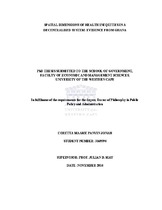| dc.description.abstract | Decentralisation has been considered by many as one of the most important strategies in public sector reform in several of the developing countries. Both donors and governments have regarded decentralisation as a tool for national development through the realisation of the objectives of enhancing popular participation in development and the management of development at the regional or local level. Countries are expected to reap the benefits of decentralisation through improved service delivery, namely, through bringing service delivery closer to the consumers, improving the responsiveness of the central government to public demands and,thereby,reducing poverty and inequalities, improving the efficiency and quality of the public services and empowering lower levels of government to feel more involved and in control. However, decentralisation also has the potential to widen the gap in fiscal resources at the sub-national leveland this may, in turn, result in inequities in service delivery tocitizens of the same countryanddepending on where they live. Over the years Ghana has experimented with amix of decentralisation reforms with the current policy integrating elements of political, administrative and economic decentralisation. The current system of local government in Ghana is based on a decentralisation programme that was launched in 1988 with the introduction of district assemblies (DAs) by the Provisional National Defence Council (PNDC) government. Nevertheless, years after the launch of the decentralisation process there are still significant disparities and inequities between districts and regions in Ghana as regards health variables. This study set out to investigate the link between decentralisation and health inequities by exploring the spatial dimensions of health equities in Ghana. The thesis used a concurrent mixed method approach by combining a quantitative inequality indices analysis and a qualitative analysis of interviews with policy makers in both the health sector and the decentralised system. The analysis used household level data from the Ghana Demographic and Health Survey 2003 and 2008 to construct inequality curves and indices in order to illustrate the existing inequities across and within regions in Ghana after an increase in the intensity of decentralisation. The study then decomposed the indices to determine the extent to which these inequities were accounted for by variations both within the regions and between the regions. The thesis also used available data from the common fund records of district assemblies to assess the level of inequities in selected health resources across districts. The thesis then investigated the micro-foundations of health decentralisation using the qualitative and quantitative descriptive analyses. The analysis conducted revealed that inequities in maternal health utilisation decreased between 2003 and 2008‒the two data points used based on theresearch design. However,these inequities were attributed primarily to within region inequities as the level of between regions inequities was significantly lower for both the concentration index and the Theil’s index. However, although, at the regional level the general trend revealed that inequities had also decreasedbetween 2003 and 2008, some individual region s had recorded increases. The concentration index, which provided information on the gradient of the inequities, revealed that the health inequities in Ghana‒the total health inequities and also for both years between and within regions‒were pro rich. In the instances of the regional inequities these inequities generally manifested a pro rich nature, with the exception of the Upper East region which had showed pro poor inequities in 2008. The analysis of the district level inequities in selected health resources and as regards health facilities, doctors and nurses indicated that the distribution of these facilities favoured the richer districts as the inequities revealed a pro rich gradient. The inequities in the health facilities at the district level were highest in respect of the nurses, followed by doctors and health facilities with scores of 0.32, 0.29 and 0.084 respectively. The analysis of the qualitative data corroborated the results of the quantitative analysis as it emerged that policy makers at all levels believed that, over the years since the decentralisation, inequities had reduced, albeit marginally. The policy makers highlighted the high levels of the inequities in health resources,especially human resources,as a major area of concern. However, they also raised major concerns regarding inequities within regions, arguing that a number of factors, includingthe nature of the decentralisation regime in Ghana, the variations in the economic strength of districts and certain political factors,continued to cause inequities within the decentralised system. They argued that these factors impacted on the ability of both districts and regions to address inequities at a local level. In addition, they also pointed to the need to re-examine the definition of inequities in the Ghana health sector, inequities which result from focusing the attention on a number of regions and areas to the detriment of others. | en_US |

